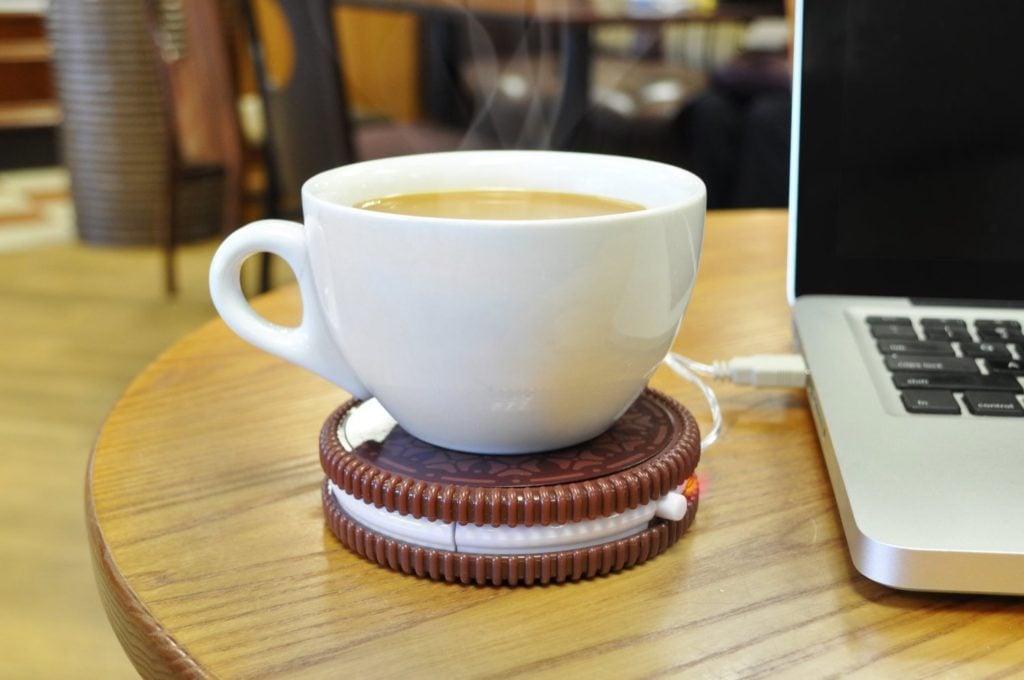Two engineers left this incredibly detailed one-star product review of a Mustard USB Cup Mug Warmer Coaster on Amazon. The product claims to keep tea warm, so the engineers put the claims to the test in a review called “Two engineers, one cup: a scientific investigation into Mustard’s 50ºC claim.”

Source: Amazon UK
After receiving this item as a Christmas present, I immediately saw its potential for keeping my tea warm at my desk whilst I’m working in the electronics laboratory where beverages, hot or cold, are forbidden (for obvious reasons). Imagine my disappointment then when, on my first day back at work after the Christmas break, I made myself a nice cup of Earl Grey, went to the lab for a while, and then came back to find my tea cold. Certainly not the 50ºC at which this product claims to keep your tea. It was then that I decided to finally put my physics degree and electrical engineering PhD to good use by subjecting the Mustard Hot Cookie to a scientific investigation.

Figure 1 shows my test set-up. A k-type temperature probe, connected to a Pico-logger (which in turn was connected to a PC), was inserted into a mug of hot water which was placed on top of the Mustard Hot Cookie coaster. The water was decanted into the mug from the boiler in the work’s kitchen and the whole test set-up was placed in an environmentally-controlled laboratory (in other words, our electronics lab has air conditioning).
The first test was the control. The mug of water was placed on the coaster, but the coaster was not plugged into the USB port of the PC. The PC logged temperature data every minute for over two hours. The second test was performed with the coaster plugged into the USB port and switched on. It was seen that there was very little thermal contact between the mug and the top of the coaster. The instructions say to use a flat-bottomed drinking receptacle, but as far as I am aware, all common mugs have a rim around the circumference of the base that keeps most of the mug from actually making contact with the coaster. To remedy this, a third test was performed using a thermally-conductive gasket placed under the mug to increase its thermal contact with the coaster (see figure 2).

Figure 3 shows the results. The control test (light blue line) saw the water temperature fall to 35ºC after the first hour and to 26ºC after the second hour. With the Hot Cookie switched on (test 2, brown line), there was only a small improvement, with the water at 39ºC after one hour and at 32ºC after two hours. Surprisingly, the thermally-conductive gasket made to difference to the results seen in test 2 (grey line hidden behind the brown line). These results show that the claims made by Mustard that the Hot Cookie keeps your drink at 50ºC were plainly false. The only thing with an elevated temperature was clearly the hot air spouted by Mustard.

At this point in my investigation, my boss saw what I was up to: i.e., not getting on with my proper work and breaking the rules about having drinks in the laboratory. That was when he suggested that I should use an external power supply to increase the power dissipation of the coaster. A USB port in a PC provides 0.5A of current at a voltage of 5V, giving a total power dissipation of 2.5W (P=VI). USB phone chargers are available however that can provide 2.1A at 5V. That’s a power rating of 10.5W. However, the coaster needed to be modified in order for it to draw 2.1A of current. This involved opening up the coaster, removing its internal workings, and installing a 2.2 Ohm resistor rated to 50W. A thermally-conductive compound was used to provide good contact with the top of the coaster and some thermally-resistive packaging foam was used to keep the resistor in place.
Using Ohm’s Law (V=IR), in order to get 10.5W of power dissipation, it was calculated that the voltage supplied by the external power supply to the now-modified coaster needed to be 4.8V, thus giving a current consumption of 2.2A: close enough to the aforementioned USB phone charger for the scope of this study. As before, the mug was filled with hot water and placed on the now-modified coaster and the temperature was logged for two hours. Again, this test was repeated using the thermally-conductive gasket.
Figure 3 shows that with the modified coaster powered to give a power dissipation of 10.5W, the temperature falls to just below 43ºC after two hours (yellow line). This time though, the gasket makes a small difference, and after two hours, the temperature is 44.5ºC. This is still 5.5ºC below the claimed 50ºC that is made by the manufacturer.
As well as measuring the water temperature, the temperature of the top of the coaster was noted after if had been left to heat up sufficiently. The unmodified coaster top surface reached 50ºC whereas the modified coaster reached 90ºC. It can be concluded therefore that even though the current design simply doesn’t keep the drink at 50ºC, a re-design has the potential of fulfilling this claim. However, there is the added health and safety risk of having a 90ºC hot surface on your desk.
Not satisfied with this result, my boss insisted that I push the modified coaster to its limit by increasing the power dissipation to its full 50W. At the first attempt, the solder to the resistor melted and the wires to the power supply fell off. We re-attached the wires using crimps. However, in switching on again at 50W, the thermally-resistive packaging foam that was placed inside the coaster started to melt and give off toxic fumes. This additional test was therefore abandoned.
Conclusions: this coaster falls well short of the claim that it keeps your drink at 50ºC. Modifying the coaster brings it closer at around 45ºC, but the coaster itself gets dangerously hot. In short, this product just doesn’t cut the Mustard. Ha ha ha! Mustard!
Source: Amazon UK
Related: Funny Product Reviews on Amazon


